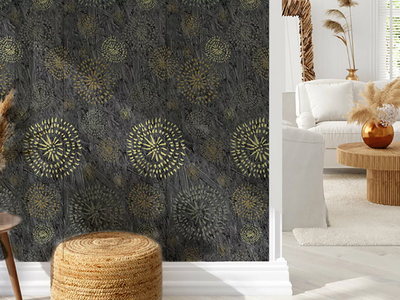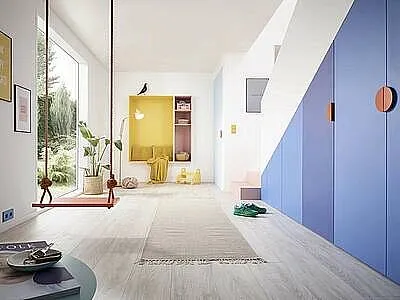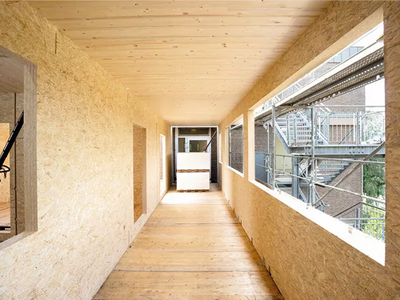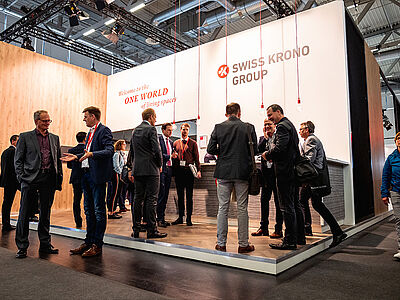OSB with Emission Class E1 – What Does This Mean?
This article explains exactly what it means when an OSB product has an emission class of E1, as well as why engineered wood products are classified at all.
Emissions – in other words, released gases – are a sensitive but frequently discussed topic in connection with engineered wood. It’s fairly common for products to acquire a bad reputation they don’t deserve just because they contain certain naturally occurring substances, in addition to others that get there inadvertently as a side-effect of production or are intentionally added for one reason or another. Yet there are enormous differences! It’s important to distinguish between high-quality, eco-friendly engineered wood products that pose no health risks on the one hand, and on the other low-quality products which can be unhealthy due to added ingredients or possibly even because they are made from contaminated used wood.
The tendency of engineered wood to emit formaldehyde continues to be a contentious topic, despite the fact that nowadays this rarely poses significant health risks under normal conditions. Of greater concern are, in many cases, the binders added to facilitate production. These can also contain harmful formaldehyde. Formaldehyde – a toxic, colourless, flammable gas with a sour, pungent odour – belongs to the group of volatile organic compounds, or VOCs for short. In high concentrations, formaldehyde has been officially classified as carcinogenic and can also cause skin rashes, allergies and respiratory problems.
It’s therefore important to be discerning and choose certified high-quality merchandise –not all engineered wood is created equal! Glulam, particleboard, OSB and fibreboard, all of which fall into the category of engineered wood, often contain added binders. But the hazards involved can vary greatly. The emission class tells us more.
Breathe Easy with Naturally Low-Emission Engineered Wood Products from SWISS KRONO
All SWISS KRONO engineered wood products are sustainably produced and stand out with especially low emissions. The production of SWISS KRONO OSB involves a synthesis of wood (a natural raw material) and innovative technology. SWISS KRONO uses one of the world’s most advanced plants for non-stop production of its versatile OSB boards. Only fresh thinnings from sustainably managed domestic German forests are used to make them.
To produce engineered wood products that are good for both human health and the environment, for decades SWISS KRONO has dispensed entirely with formaldehyde-containing binders. To produce its OSB, the firm uses only minimal amounts of binder consisting exclusively of formaldehyde-free bonding resins that is known as pMDI glue. Using formaldehyde-free binders ensures that engineered wood materials from SWISS KRONO contain only the formaldehyde that is naturally bound up in the wood. With emissions of only 0.01 ppm, all SWISS KRONO OSB products are well below the limit of 0.1 ppm mandated by the E1 guideline.
As SWISS KRONO plays a leading role in the engineered wood industry, it feels especially obligated to help safeguard the environment and has therefore pledged to prevent contamination as far as possible while working to steadily improve the environmental compatibility of its production processes. SWISS KRONO strives to minimise its consumption of raw materials, water and energy, recycles and reuses wastewater, energy and heat, and even takes advantage of production scrap to minimise its fossil fuel requirement. In addition, SWISS KRONO has publicly declared its commitment to environmental protection and backs this up by demonstrating its compliance with global standards. The firm uses environmental product declarations (EPDs) to openly and transparently communicate the environmental footprints of its engineered wood products.
Only complete, unreserved disclosure of product lifecycles and environmental footprints serves a purpose by enabling consumers to objectively compare alternatives.
Emission Classes: Greater Transparency for the Sake of Our Health
Many years ago, most of the formaldehyde found inside buildings came from engineered wood products. In the late 1970s, the (subsequently dissolved) German Federal Health Agency recommended that the formaldehyde concentration in the air of inhabited rooms should not exceed 0.1 parts per million (ppm). To minimise health risks and protect consumers, in 1980 Germany established national guidelines which defined three classes – called E1, E2 and E3 – for the formaldehyde emissions of engineered wood products. These later served as the basis for similar emission classes at European level.
EN 717-1 defines a method for determining the formaldehyde emissions of individual engineered wood boards and panels. A square metre of a flat product is placed in a test chamber having a volume of one cubic metre, then the amount of formaldehyde it releases is measured. The air of the chamber may not contain more than 0.1 ppm, and various associations insist on an even stricter ceiling of 0.03 ppm. SWISS KRONO products boast a value of only 0.01 ppm, or well below the official limit, and contain only the formaldehyde that naturally occurs in wood. Strictly speaking, SWISS KRONO OSB only has a value of 0.005 ppm as the test chamber has a background concentration of 0.005 ppm of formaldehyde before a sample is placed in it.
E1:
Engineered wood products classified as E1 do not emit more than 0.1 ppm of formaldehyde into the ambient air. This label characterises an engineered wood product that is unobjectionable for almost all intents and purposes and may be used for interior finishing and furniture. All engineered wood products from SWISS KRONO are classed as E1. To stress the added value of formaldehyde-free binding and the resulting greatly reduced emissions, “F0-glued” is added. What this means is explained further below.
E2:
Class E2 engineered wood products emit a maximum of 1.0 ppm of formaldehyde into the ambient air. However, they have been banned in Germany and may no longer be sold.
E3:
For this classification, which is the worst, engineered wood products may not release more than 1.4 ppm of formaldehyde. Like E2, they are no longer permitted in Germany.
F0:
This classification was created by SWISS KRONO and does not have the status of a standard. F0 means that the binder used contains no formaldehyde whatsoever. SWISS KRONO OSB is declared as E1, plus the predicate “F0-glued” to make it quite clear that these products are even better than the already strict E1 classification.
Some manufacturers also advertise their engineered wood products as having an “E0” classification. This suggests that they are completely free of formaldehyde, but is misleading because all wood naturally emits some formaldehyde and, at least so far, no E0 standard actually exists in Germany or the European Union. Even engineered wood panels glued with formaldehyde-free binder gives off a miniscule amount of formaldehyde.
Since 1980, only class E1 engineered wood materials have been permitted for interior applications in Germany. The idea is to prevent formaldehyde concentrations greater than 124 µg/m³ (0.1 ppm) in indoor air. The World Health Organisation (WHO) even recommends playing it safe by keeping the levels at or below 60 µg/m³. This roughly corresponds to the current average contamination level inside buildings in Germany.
The emissions of SWISS KRONO OSB panels, at only 0.01 ppm, are far below those required by the E1 standard of 0.1 ppm. They are even less than the stricter ceiling of 0.03 ppm that various timber construction associations (e.g. Blue Angel, the German Association for Prefabricated Timber Construction, the Association for Quality in Timber Construction, Interior Finishing and Roofing, etc.) are calling for.
The most inportant facts about EPDs
Only pMDI glues are used to bind the strands for SWISS KRONO OSB. This compound – its full name is polymeric methylene diphenyl diisocyanate – is free of formaldehyde and highly resistant to moisture. Only tiny amounts of it are needed for binding purposes, although it is more expensive and work-intensive to use. Many manufacturers therefore resort to other glues such as phenol-melamine-urea formaldehyde or MUF (melamine urea formaldehyde). Although it is common for OSB to have a binder content of between 10% and 15%, SWISS KRONO only adds between 2.5% and 4%. Once bound up in the product, moreover, the glue is absolutely emission-free and even food-safe.







